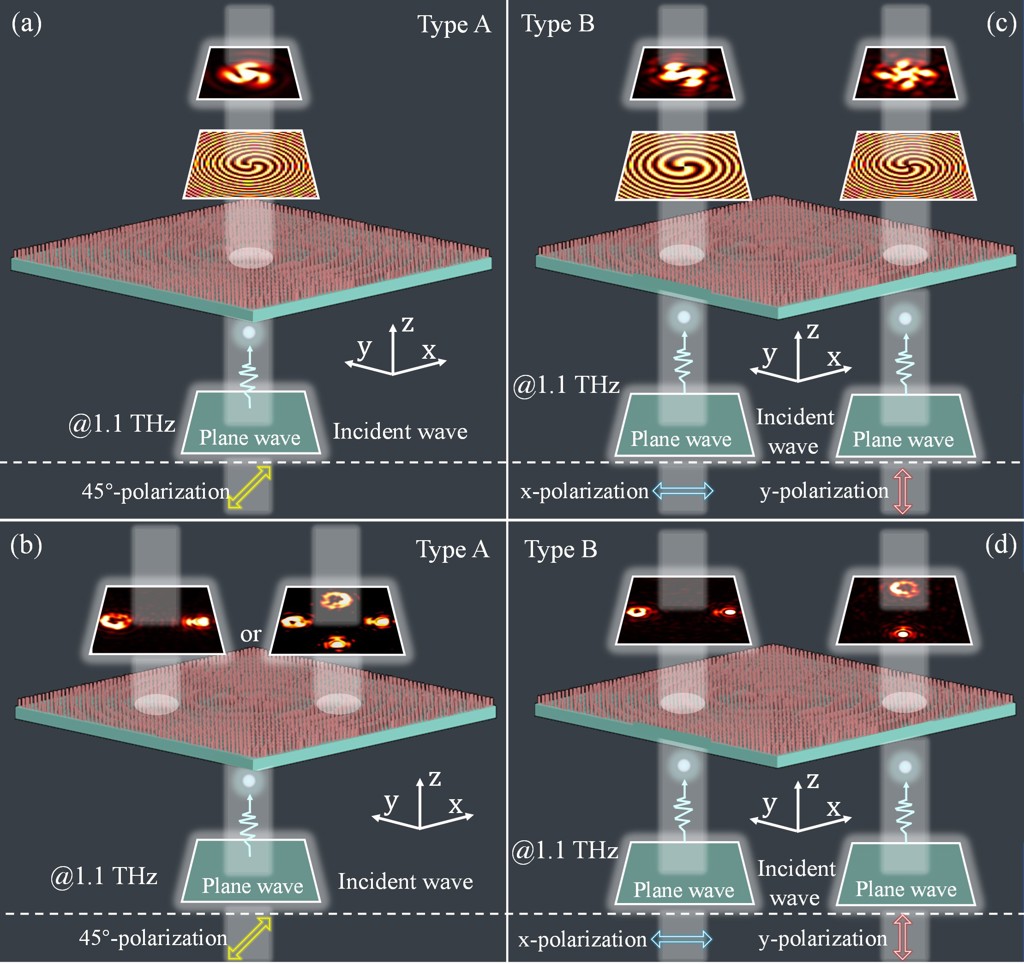Researchers create metasurface that enables multichannel terahertz transmission
About Optica
28 February 2023
Researchers create metasurface that enables multichannel terahertz transmission
Tiny metasurface devices could help improve communication, terahertz imaging, manipulating particles and encoding of quantum information

Caption: Researchers created metasurface devices for linear polarization multichannel transmission and superposition states of spherical and vortex waves. (a) Superposition state of spherical wave and vortex wave under 45° polarized wave incidence. (b) Four-channel transmission of two spherical waves and two vortex waves can be carried under 45° polarized wave incidence. (c) Superposition states of spherical wave and vortex under x and y polarized wave incidence, respectively. (d) Two-channel transmission of a spherical wave and a vortex wave can be carried under x (or y) polarized wave incidence.
Credit: Fuyu Li, University of Electronic Science and Technology of China
WASHINGTON — Researchers have designed and demonstrated two all-silicon terahertz metasurface devices that can be used to create four optical channels for simultaneously implementing different optical functions. This capability could be useful for a variety of applications such as communication, terahertz imaging, particle manipulation or encoding quantum information.
The new technology could, for example, help ease the transition to faster 6G wireless networks, which will likely be based on high frequency waves such as those in the terahertz region.
“6G networks will likely require more base stations to achieve full signal coverage,” said research team leader Fuyu Li from the University of Electronic Science and Technology of China. “The multiple channels produced by our devices could be used to simultaneously achieve beam deflection at multiple frequencies, which would reduce the need for more base stations and accelerate the arrival of 6G communications.”
In the Chinese Laser Press and Optica Publishing Group journal Photonics Research, the researchers describe the new devices, which represent a completely new method for superimposing various forms of terahertz waves, including focused, spherical and vortex waves. When waves are superpositioned, they are essentially added together to produce a new type of wave that is the sum of the original components.
“We combined artificial metasurfaces that have special electromagnetic properties with the superposition states of different forms of terahertz waves,” said Li. “This unique combination offers many degrees of freedom, which can be used to create more versatile terahertz devices. Such devices could increase the precision of particle manipulation or broaden the channels of optical communication, for example.”
Versatile devices
In the new work, the researchers used metasurfaces that are 500 μm thick to create two terahertz devices. Metasurfaces are materials engineered with tiny nanostructures that can be used to manipulate light.
The first device they made uses the polarization state of a terahertz wave as a switch to select the information carried by the superpositioned states of vortex and spherical waves. Spherical waves propagate outward in all possible directions while vortex waves have a special helical shape. This twisting shape creates a rotational movement that imparts orbital angular momentum (OAM), which can be used to carry information or move particles.
This device could use the polarization state of the incident electromagnetic wave as a selection switch for the number of interference fringes, which could be useful for interferometry, Doppler analysis and other applications. In this case, when x-polarized waves hit the metasurface vertically, it would create an interference pattern with two clockwise spiral stripes.
The researchers also designed a second device that can use the polarization state of the terahertz wave as a switch to select the number of channels for multi-channel transmission. For example, when two waves with x-polarizations hit the metasurface vertically, then the transmitted wave has two channels: left and right. These two channels carry vortex and spherical waves, respectively, without any interference.
Enabling new terahertz applications
“This work could help OAM become a carrier for information transmission between photons and objects,” said Li. “It could also enable new ultra-thin photonic devices that facilitate the development of terahertz information encryption and high-frequency communications.”
After demonstrating both superposition states and multi-channel transmission of vortex and spherical waves theoretically, they also performed simulations and experiments. In the experimental tests, the researchers measured superposition states between the vortex and spherical waves close to the focal plane, showing that the device worked well. They also showed that the direction of rotation and intensity of spiral interference stripes produced were consistent with the theoretical and simulated designs.
The researchers are now working to integrate more functionality into the metasurfaces. They also want to improve the signal-to-noise ratio in their testing systems so that they can observe even smaller physical phenomena produced with metasurfaces.
Paper: F. Li, Y. Li, T. Tang, Y. Lu, X. Liu, Y. Liao, Q. Wen, “All-dielectric terahertz metasurface for linearly-polarized multichannel transmission and superposition states of spherical and vortex waves,” Photonics Research, 11, 3, 485-493 (2023).
DOI: doi.org/10.1354/PRJ.477381
About Optica Publishing Group
Optica Publishing Group is a division of the society, Optica, Advancing Optics and Photonics Worldwide. It publishes the largest collection of peer-reviewed and most-cited content in optics and photonics, including 18 prestigious journals, the society’s flagship member magazine, and papers and videos from more than 835 conferences. With over 400,000 journal articles, conference papers and videos to search, discover and access, our publications portfolio represents the full range of research in the field from around the globe.
About Photonics Research
Photonics Research disseminates fundamental and applied research progress in optics and photonics. Published by Chinese Laser Press and Optica Publishing Group and led by Editor-in-Chief Lan Yang, Washington University in St. Louis, USA. For more information, visit Photonics Research.
Media Contact
